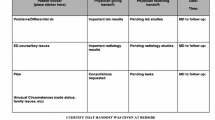ABSTRACT
BACKGROUND
Poor quality handoffs have been identified as a major patient safety issue.
In residency programs, problematic handoffs may be an unintended consequence of duty-hour restrictions, and key data are frequently omitted from written handoffs because of the lack of standardization of content.
OBJECTIVE
Determine whether an intervention that facilitates face-to-face communication supported by an electronic template improves the quality and safety of handoffs.
DESIGN
Before-after trial.
PARTICIPANTS
Thirty-nine interns providing nighttime coverage over 132 intern shifts, representing ∼9,200 handoffs.
INTERVENTIONS
Two interventions were implemented serially—an alteration of the shift model to facilitate face-to-face verbal communication between the primary and nighttime covering physicians and an electronic template for the day-to-night handoff.
MEASUREMENTS
Overall satisfaction and handoff quality were measured using a survey tool administered at the end of each intern shift. Written handoff quality, specifically the documentation of key components, was also assessed before and after the template intervention by study investigators. Interns used the survey tool to report patient safety events related to poor quality handoffs, which were validated by study investigators.
RESULTS
In adjusted analyses comparing intern cohorts with similar levels of training, overall satisfaction with the new handoff processes improved significantly (p < 0.001) post intervention. Verbal handoff quality (4/10 measures) and written handoff quality (5/6 measures) also improved significantly. Study investigators also found significant improvement in documentation of key components in the written handoff. Interns reported significantly fewer reported data omissions (p = 0.001) and a non-significant reduction in near misses (p = 0.056), but no significant difference in adverse events (p = 0.41) post intervention.
CONCLUSIONS
Redesign of shift models common in residency programs to minimize the number of handoffs and facilitate face-to-face communication, along with implementation of electronic handoff templates, improves the quality of handoffs in a learning environment.


Similar content being viewed by others
REFERENCES
Vidyarthi AR, Arora V, Schnipper JL, Wall SD, Wachter RM. Managing discontinuity in academic medical centers: strategies for a safe and effective resident sign-out. J Hosp Med. 2006;1(4):257–66.
Arora V, Johnson J, Lovinger D, Humphrey HJ, Meltzer DO. Communication failures in patient sign-out and suggestions for improvement: a critical incident analysis. Qual Saf Health Care. 2005;14(6):401–7.
Horwitz LI, Moin T, Krumholz HM, Wang L, Bradley EH. Consequences of inadequate sign-out for patient care. Arch Intern Med. 2008;168(16):1755–60.
Lofgren RP, Gottlieb D, Williams RA, Rich EC. Post-call transfer of resident responsibility: its effect on patient care. J Gen Intern Med. 1990;5(6):501–5.
Johnson JK, Arora VM. Improving clinical handovers: creating local solutions for a global problem. Qual Saf Health Care. 2009;18(4):244–5.
Arora VM, Johnson JK, Meltzer DO, Humphrey HJ. A theoretical framework and competency-based approach to improving handoffs. Qual Saf Health Care. 2008;17(1):11–4.
Horwitz LI, Moin T, Krumholz HM, Wang L, Bradley EH. What are covering doctors told about their patients? Analysis of sign-out among internal medicine house staff. Qual Saf Health Care. 2009;18(4):248–55.
Horwitz LI, Krumholz HM, Green ML, Huot SJ. Transfers of patient care between house staff on internal medicine wards: a national survey. Arch Intern Med. 2006;166(11):1173–7.
Philibert I. Use of strategies from high-reliability organisations to the patient hand-off by resident physicians: practical implications. Qual Saf Health Care. 2009;18(4):261–6.
Wayne JD, Tyagi R, Reinhardt G, Rooney D, Makoul G, Chopra S, et al. Simple standardized patient handoff system that increases accuracy and completeness. J Surg Educ. 2008;65(6):476–85.
Van Eaton EG, Horvath KD, Lober WB, Rossini AJ, Pellegrini CA. A randomized, controlled trial evaluating the impact of a computerized rounding and sign-out system on continuity of care and resident work hours. J Am Coll Surg. 2005;200(4):538–45.
Horwitz LI, Moin T, Green ML. Development and implementation of an oral sign-out skills curriculum. J Gen Intern Med. 2007;22(10):1470–4.
Arora V, Johnson J. A model for building a standardized hand-off protocol. Jt Comm J Qual Patient Saf. 2006;32(11):646–55.
Solet DJ, Norvell JM, Rutan GH, Frankel RM. Lost in translation: challenges and opportunities in physician-to-physician communication during patient handoffs. Acad Med. 2005;80(12):1094–9.
Cohen MD, Hilligoss PB. The published literature on handoffs in hospitals: deficiencies identified in an extensive review. Qual Saf Health Care. 2010;19(6):493–7.
Patterson ES, Wears RL. Patient handoffs: standardized and reliable measurement tools remain elusive. Jt Comm J Qual Patient Saf. 2010;36(2):52–61.
Patterson ES, Roth EM, Woods DD, Chow R, Gomes JO. Handoff strategies in settings with high consequences for failure: lessons for health care operations. Int J Qual Health Care. 2004;16(2):125–32.
Jeffcott SA, Evans SM, Cameron PA, Chin GS, Ibrahim JE. Improving measurement in clinical handover. Qual Saf Health Care. 2009;18(4):272–7.
Petersen LA, Brennan TA, O’Neil AC, Cook EF, Lee TH. Does housestaff discontinuity of care increase the risk for preventable adverse events? Ann Intern Med. 1994;121(11):866–72.
Petersen LA, Orav EJ, Teich JM, O’Neil AC, Brennan TA. Using a computerized sign-out program to improve continuity of inpatient care and prevent adverse events. Jt Comm J Qual Improv. 1998;24(2):77–87.
Funders
Dr. Graham is supported by a Health Resources and Services Administration training grant (T32 HP12706). Dr. Marcantonio is supported by a Midcareer Investigator Award in Patient-Oriented Research from the National Institute on Aging (K24 AG035075). This work was also conducted with support from Harvard Catalyst (NIH Award #UL1 RR 025758) and financial contributions from Harvard University and its affiliated academic health care centers. None of the aforementioned funding sources had a role in the design, conduct, collection, analysis, or interpretation of the data or in the preparation, review or approval of the manuscript.
This work was presented at the New England Regional SGIM conference as an oral abstract on March 8, 2013.
Conflicts of Interest
No authors report any conflicts of interest.
Author information
Authors and Affiliations
Corresponding author
Electronic supplementary material
Below is the link to the electronic supplementary material.
ESM 1
(PDF 835 kb)
Rights and permissions
About this article
Cite this article
Graham, K.L., Marcantonio, E.R., Huang, G.C. et al. Effect of a Systems Intervention on the Quality and Safety of Patient Handoffs in an Internal Medicine Residency Program. J GEN INTERN MED 28, 986–993 (2013). https://doi.org/10.1007/s11606-013-2391-7
Published:
Issue Date:
DOI: https://doi.org/10.1007/s11606-013-2391-7




